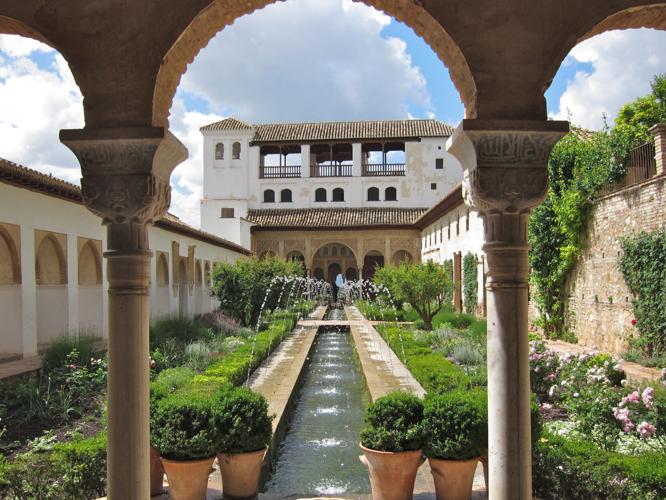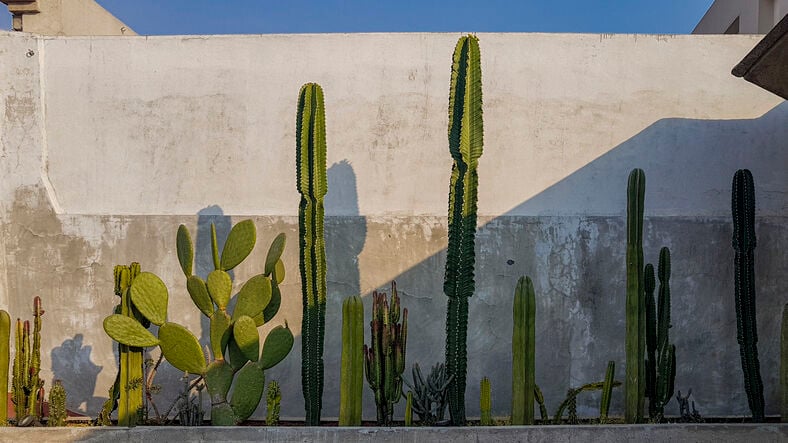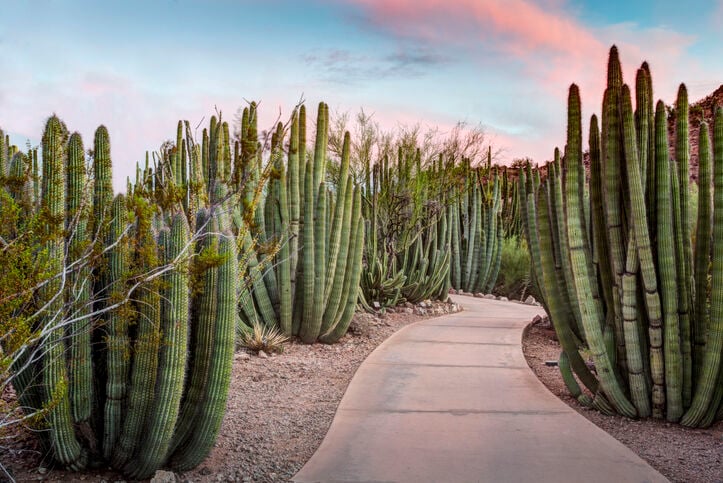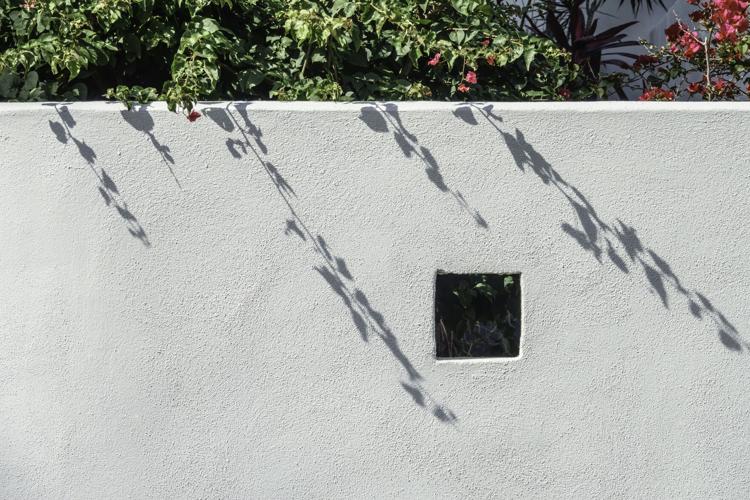Gardens are very individual. Everyone has a different vision of how they would like their garden to look. There are a number of different garden designs to choose from. In our climate, one of the more difficult ones is the formal garden.
This is because classic formal gardens usually include a lot of sheared shrubs with geometric forms. Unfortunately, many of our native plants, and other drought-tolerant plants, don’t respond well to shearing. However, there are a number of other options if you like the formal garden look, and are willing to think outside the box a little.
Formal gardens are characterized by bold, geometric shapes, straight lines, symmetry and repetition. You have square or columnar plant forms, straight paths, rectangles, boxes, spheres and cylinders. What desert-adapted and native plants can we use to duplicate this look? Read on!

Contemporary and formal design uses repetition of color, shape or texture. Here, the monolithic wall and the repetition of cacti adds visual interest to a narrow, tall area of the garden.
Cacti, succulents and other desert dwellers
Your best friends are going to be cacti and other succulents. Columnar cacti like the organ pipe cactus (Stenocereus thurberi) or Mexican fencepost (Pachycereus marginatus) can give you the tall, vertical, tidy shapes that look so good in a formal garden design. Another great option is totem pole cactus, (Pachycereus schottii) which has unique geometric shapes to its stems. You can use these in place of tall sheared hedges.

This path through organ pipe (Stenocereus thurberi) cactus plants shows how repetition can lead to pleasing balance and entice the visitor to move through the space.
Agave, yucca, candelilla, and even hesperaloe can also give you the geometric forms that are characteristic of formal designs. For example, octopus agave (Agave vilmoriniana) has beautiful curvy and spiky shapes while our native Parry’s agave (Agave parryi) has wide, spoon-like layered leaves; both will add visual depth and interest to your garden. For thin, vertical accents, you can plant candelilla (Euphorbia antisyphilitica), desert milkweed (Asclepius subulata), and ocotillo (Fouquieria splendens). Desert spoon (Dasylirion wheeleri) gives you both a rounded overall shape and narrow spiky leaves which give a great visual effect when they move in the wind. You can use rounded cacti like golden barrels (Echinocactus grusonii) to introduce spherical shapes.
Shrubs and trees
A few plants that do well in our climate can be sheared into formal shapes. One of these is jojoba (Simmondsia chinensis). Rosemary (Salvia rosmarinus) is another. You can also potentially do this with citrus, but there are a couple of big caveats: the trunk will sunburn if not covered by the leaf canopy, so take this into consideration. You also will need to provide extra water and feeding due to the increased stresses on the plant. You can read to your heart’s content about citrus on the University of Arizona’s publications page and decide if it’s right for you.

Mediterranean style fountains can fit very well into a formal garden design.
Mounded low shrubs can also be used to give some round shapes to your garden. A couple of good candidates are damianita (Chrysactinia mexicana) and flattop buckwheat (Erigonum fasciculatum). The advantage of flowering shrubs is that they add to the visual interest and add color to your landscape when they bloom.
You will probably want some trees in your design. Choose trees with interesting visual features — it’s OK if they’re not as regular-shaped as your other plants. Some candidates are featherbush (Lysiloma watsonii), which has soft, feather-like leaves and round puffball flowers; palo blanco (Mariosousa willardiana), which has a distinctive svelte form and striking white peeling bark, and ironwood (Olneya tesota) which has a beautiful gray textured bark and gray-green finely shaped foliage.
Don’t forget about palms, which are a staple of Mediterranean gardens and provide sharp vertical accents. There are lots of options; one native palm is the California fan palm (Washingtonia filifera) which does well in our climate. Check out this great guide to palm trees from the University of Arizona Extension office for more ideas.
Whatever plants you decide on, keep in mind that a major design feature of formal gardens is repetition. To this end, choose a few plants for your design and repeat them throughout your space. This will help achieve the visual calm, order and harmony that formal gardens are known for. You can also choose to repeat shapes and colors.

This tidy masonry wall with a square cutout and clean lines is a perfect example of formal design.
Hardscape
When considering your hardscape, again go with regular shapes. Squares and rectangles in particular are popular in formal designs. For a less severe look, you can choose spheres, ovals and circles. In Middle Eastern and Mediterranean-style gardens, more complex and ornate geometric shapes can be used. Materials to consider are concrete, square or rectangular pavers, natural stone, and bricks. I recommend using permeable paving to reduce water runoff and encourage infiltration into your garden soil. You can also go with gravel, which will be your least expensive option (and is permeable to water). You can choose a number of different colors for your gravel, from tan to rose to gray.
Low walls are also frequently used in formal gardens to delineate space, as are planters. Planters can be of nearly any material, but you will want to stay consistent and keep to one shape, color or material in the same visual areas of your space. Columns are also frequently used in formal gardens to direct the eye upward and out into the space, and to create repetition. Also, don’t forget about using tile as a decorative element. Geometric or natural tile patterns can go well with formal designs and can add extra color and depth to your design.
Finally, you may want to consider a water feature. Rectangular, round and square pools or fountains are good candidates, but you can also go with a Mediterranean-style tiered fountain. Water features soften the look of formal gardens, and it’s always nice to have the sound of water in a desert garden. It will also attract wildlife.
For some more design inspiration check out the video below.
Inspiration on how to use desert-adapted plants in a formal garden design in the Tucson desert. Video by Dominika Heusinkveld/Arizona Daily Star









